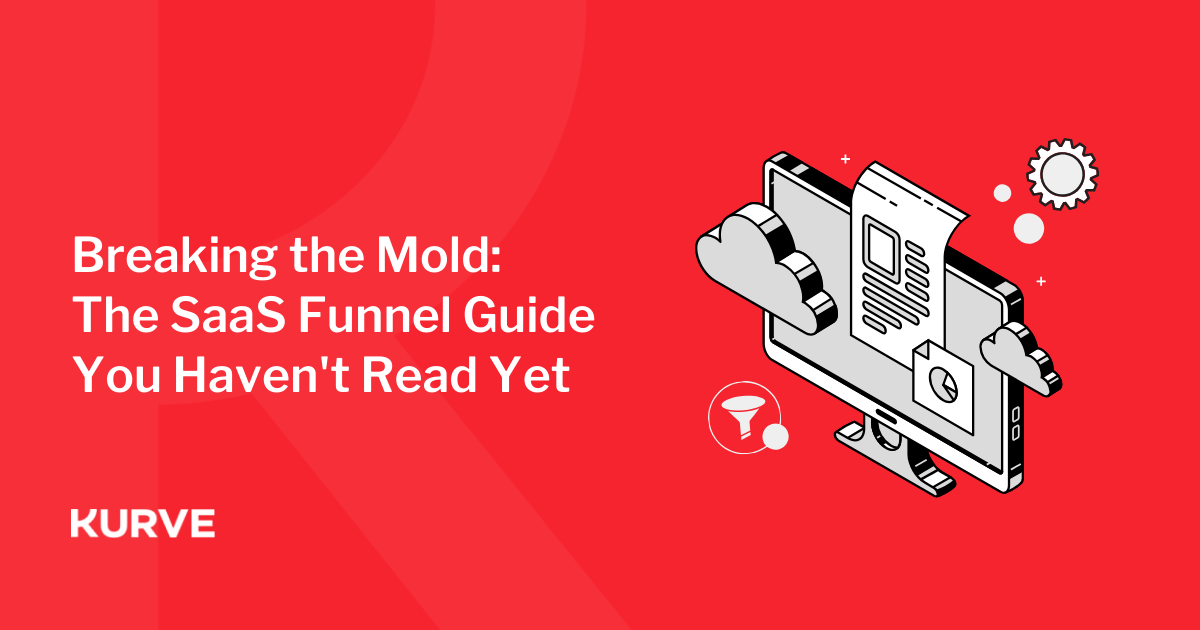Growth Hacking: Your Complete Guide
Growth Hacking: Your Complete Guide
What is Growth Hacking?

This is a comprehensive guide to growth hacking, written by Oren Greenberg. He is an experienced London-based growth marketer, working with startups and scale-ups to power growth through digital channels. This growth hacking guide is based on Oren's video course, Grow Your Business Through Growth Hacking Experiments, which you can access on Skillshare.
Growth Hacking Definition and Principles
Since the concept of growth hacking was defined by Sean Ellis in 2010, this innovative approach to marketing has skyrocketed. But what actually is growth hacking, and how can you use this methodology to grow your own business? Throughout this guide to growth hacking, I’ll take you through the basics of the growth hacking framework and how to put it into practice. During this first section, we’ll begin by defining the term, discuss how growth hacking differs from traditional marketing, and we’ll consider when it’s the right time to go through the growth hacking process...
What is growth hacking?
Growth hacking, as the phrase suggests, is all about driving intense growth in your business . In order to kick-start this growth, you need to experiment . Running lots of experiments on different digital marketing channels will allow you to gain the key insights you need to get real results from your marketing activities. It’s essential to run these experiments on the channels that are guiding your particular audience towards your specific product. You need to uncover what is motivating (and demotivating) your audience to convert from visitors to regular product users. That’s the way to drive real, sustainable long-term growth for your business.
Growth hacking vs. traditional marketing
Traditional marketing is broader in scope than growth hacking. When you think about traditional marketing techniques, you might consider cold calling, developing brand perception, putting adverts on billboards, or TV, etc. Growth hacking has evolved hand-in-hand with digital marketing channels. Utilising the vast amount of data gathered through digital marketing, growth hacking allows you to analyse your product's performance quicker and more deeply than ever before. Now you can experiment rapidly with Google Ads, user interface, web design, Facebook and Twitter engagement, and much (much!) more. These channels enable you to conduct multiple tests swiftly and iteratively, so you can learn what works for your audience. Through this approach, you can drive growth at a faster rate than is possible with traditional approaches to marketing.
What kind of tests can you run?
Using off-the-shelf or in-house analysis tools, you can test the metrics that are most relevant to your product. As just one small example, you can test multiple versions of creative or ad copy against each other, to see which ones are leading to the highest level of conversion for your website visitors and ad viewers. Growth hackers always think outside the box. Nothing is above being tested – whether it’s the colour of your CTA button, the amount of text above the fold on your homepage, or the number of blog posts you release per week. The more tests you run and the more effectively you analyse, the more likely you are to resonate with your audience and sell your product.
When growth hacking isn’t for you
It’s important to remember, however, that growth hacking isn’t a catch-all solution . For businesses at a very early stage, which haven’t yet found their product–market fit, growth hacking may not be the right approach to adopt. Growth hacking is at its strongest when leveraging a high volume of data. Once you’ve identified the right market for your product and it has begun to sell, that’s when you can collect and analyse the data necessary to growth hack your business. If you haven’t found your product–market fit, growth hacking isn’t going to work for you. You need to revisit your product and reconsider the need it is trying to fulfil. Otherwise, you risk wasting time and resources trying to implement a growth hacking framework too soon.
Wrapping up...
Growth hacking can drive substantial, sustainable growth for your business through frequent, iterative testing and analysis of your digital marketing metrics. It’s imperative that a business find their product–market fit before attempting growth hacking, or there won’t be enough relevant data to analyse. In the next section, I’ll take you through the seven core principles that any successful growth hacker needs to know.
The Seven Core Principles of Growth
In the previous section, I introduced the process of growth hacking and how it can help you achieve business growth. Next, we’ll focus in on the seven core principles that should be at the heart of any growth hacking framework.
1. Experimentation
The data needed for growth hacking is gathered when you run lots of different experiments on different marketing channels. There are numerous data analytics platforms out there – or you could develop your own in-house software. Conducting experiments will help you to determine what is driving the best results for your product and what is holding it back.
A/B testing, also known as multivariate testing, is one method to test out product, website, or ad changes by showing them to only some of your users.
This way, you can check whether what you view as an improvement will be taken the same way by your audience – before you roll it out.
2. Iterative
A successful growth hacking strategy will always involve iterative testing. That is, once you’ve run your experiments, you learn from them, you fix the weak points you’ve uncovered, and you reinforce the strengths. Then you test again. And again.
You can also begin to systematise and automate your testing, so that the results are analysed more quickly and any changes made more efficiently. Any tests that haven’t produced useful results should be replaced.
3. High Tempo
The higher the number of effective experiments you can run, the more data you will have available to analyse. The more data you can analyse, the more accurately you can determine how to grow your business.
A large quantity of data, properly managed, will allow you to gain greater clarity about what works and what doesn’t work with regard to your product and processes.
The right marketing experimentation framework will maximise the amount of data you collect and enable you to gain the most useful insights from it.
4. Cross-functional Team
Growth isn’t the task of the growth hacker alone. There needs to be a whole team focused on growth, which includes those responsible for engineering data, product development, and marketing.
Making the results of your tests available to the wider workforce can also help each employee feel engaged in the growth process. The growth strategy should be widely communicated so that all team members recognise the part they have to play.
5. North Star Metric
Out of all the metrics you measure, there will be one that is most closely linked to the value users receive from your product. This is your North Star Metric (NSM). For example, Airbnb’s NSM is “nights booked” via their platform – which provides value to hosts and guests.
Identifying your NSM is an essential part of getting your whole team on board with the growth process. One key metric reflecting the product’s core value will help to unite each part of your business around a common goal.
6. User Insight/Feedback
Analysing numerical data is a crucial part of growth hacking, but talking to people is important too! Make sure you ask for detailed feedback from your users – what do they love about your product or service? What would they change?
Both quantitative and qualitative user insights are incredibly valuable. Even the opinion of one solitary user might hold the key to driving new growth. Don’t forget to ask.
7. Ah Ha! Moment
This is the moment you want all your users to reach – the point when the value of your product or service becomes clear. The user thinks “Ah ha! I love this product and I need it in my life.” The moment will be different depending on your particular product, but you’ll usually know it has happened based on conversion or user retention.
Famously, Facebook’s Ah Ha! Moment is when a user adds seven friends within ten days. That’s when they’re likely to stick around. Experimentation can help you identify your product’s Ah Ha! Moment and how to funnel prospects towards that point.
Wrapping up...
This was a brief introduction to the seven core principles of growth behind a successful growth hacking framework. In the next seven sections, I will address each of these principles in greater depth, to help you understand more about how they work in practice.
Growth Hacking Core Principle 1: Experimentation
In the last section, I took you through the seven core principles of growth hacking. Here, we’re going to focus in on the first principle: Experimentation . How can you run the right experiments to test the performance of your product and help you grow your business? Let’s break the principle of experimentation down into four key components: audience, messaging, channels, and user experience .
1. Audience
In order to find the right audience for your product, you need to experiment. Don’t make assumptions at the start that you know exactly who your audience is. For example, we ran experiments for one client to discover what kind of audience was looking to hire local tradesmen. We targeted people on Google Ads and Facebook – same demographic, same location, different medium. The results and the ability to acquire customers cost-effectively varied hugely. Now, if you had simply assumed that an audience from a similar demographic would respond the same way on Google Ads and Facebook, you would be throwing money away on advertising. It’s imperative that you test lots of different audiences in order to find the best fit for your product or service.
2. Messaging
The next core aspect of experimentation is testing the message you’re sending to your audience. You can do this by trying out different kinds of creative in your advertising – whether that’s your copy, images, or videos. To go back to our example above, we decided to experiment with users on Adwords and Facebook who were looking for a local plumber. We ran a range of creatives where we showed people different images – of plumbers, electricians, etc. – and tested the outcome. This way, we could determine which images were sending the right message to our audience and getting them to engage with the service.
3. Channels
Another important component to experiment with is the channel for your marketing. As we saw above, users can respond quite differently depending on the channel – even if on paper they seem to be from similar demographics. Taking our plumber illustration again, we ran one campaign on Google Ads and one on Facebook. The Google Ads campaign featured just a simple ad, but it was getting great results – effective customer acquisition costs (CAC) and really engaged customers. During the Facebook campaign, on the other hand, hundreds of thousands of pounds were spent trying to get people to install a mobile app – and the campaign was a complete flop. This just goes to show that if you find the right channel, effective marketing doesn’t cost the earth. That’s why experimenting with different channels is crucial.
4. User Experience
If you want your users to stick around for the long-haul, you need to give them a great product or service experience . Once you’ve asked for feedback from users, and heard about any issues they’ve had with the product, you can experiment with different potential solutions. For example, one of our client’s users were starting to engage with the client’s mobile app. When we asked them about their experience, they said that they found a particular button confusing and weren’t sure what it did. In response, we ran experiments on new versions of the button: testing different texts, placement, and size. Engagement on the app improved by 78% - a really significant result. But it took us 13 separate experiments to find the button design and placement that worked so well. Experimentation is an iterative process, as we’ll discuss in the next lesson.
Wrapping up...
So we’ve seen that this first core principle of growth hacking, experimentation, is all about running lots of different tests to help you determine which of your marketing tools are working and which should be adjusted or set aside. Conduct experiments to find the right audience and advertising channels, test your messaging, and improve user experience – that’s the way to cost-effectively acquire new users and get them to fall in love with your product. Keep reading the next section to find out more about the second core principle of growth hacking: Iterative.
Growth Hacking Core Principle 2: Iterative
In the previous section, we discussed the first core principle of growth hacking: experimentation. The thing is, you can run huge numbers of different experiments on key performance areas, but if you don’t do this systematically you won’t get the results you’re looking for. That’s why we need the second core principle: Iterative . In this lesson, we’ll examine how the iterative mindset can save you time and money in the growth hacking process.
The closed feedback loop
When you run an experiment, you should think of it in terms of a closed feedback loop . First, you have an idea and build a prototype; second, you measure the performance of the prototype; third, you look at the data you’ve gathered and learn from it. That learning should then inform your next idea for an experiment. You can see how this closed feedback loop creates an iterative testing process where each new experiment is built on previous results. This will help you avoid repeating experiments that don’t actually work and wasting your budget.
Incremental steps
An iterative process where one experiment feeds into the next will also allow you to make incremental steps in your experimentation. That is, you make a small change to the experiment before running it again, so it’s easier to analyse what is going right or wrong. This is a much more reliable approach than, say, altering an experiment very radically or jumping on a wild idea for an experiment that might be costly and yield few results. Thinking creatively is crucial for successful growth hacking . However, making gradual, small steps in your experimentation will keep your ideas anchored in what is achievable and affordable for your business.
Case study
Here’s a case study from my own experience that demonstrates the importance of the iterative principle... The client I mentioned in the previous section had a mobile app where users could browse and choose a local tradesman to hire. We were carrying out experiments that aimed to drive traffic to the client’s landing page and get people to install the app. We were convinced that if we tested multiple different components of the landing page and got them just right, we’d achieve a fantastic result. Thus, we spent a lot of time on engineering, planning, executing – until eventually we came down to earth with a thud. We found that 95% of visitors to the page didn’t even scroll down . So, if we had been more iterative and incremental with our tests, we wouldn’t have wasted time and money trying to fix a problem with the landing page that didn’t exist.
Wrapping up...
Stick to the iterative principle and you’ll quickly discover whether or not your grand ideas for experimentation are grounded in reality. Using the closed feedback loop approach, each experiment is informed by the one before, allowing you to put what you’ve learnt into practice. Besides this, making incremental changes will ensure that your experiments remain realistic and yield reliable results. In the next section, we’ll tackle the third core principle in the growth hacking framework: High Tempo. How much data is enough data?
Growth Hacking Core Principle 3: High Tempo
In the last two sections, we saw how experimentation allows you to determine the best audience, messaging, and channels to promote your product. We also explored how an iterative, incremental approach will allow you to get the most effective results from your experiments. Here, we’ll build on these first two principles as we discuss the third core principle of growth hacking: High Tempo . How many experiments should you run and how often? What does it mean to achieve a high tempo of experimentation?
How much data is enough data?
I often get asked if there’s an ideal number of experiments to run in order to gather enough data for growth hacking purposes. Unfortunately, the answer is: no amount of data is enough data ! In order to maximise what you can learn about your performance, you really need as much data as possible. Take the example of Twitter. Twitter moved from running 0.5 experiments per week to run 10 different experiments a week – and they saw huge results. Essentially, this is about bringing scientific thinking into marketing. So often, in the past, marketing has been based on a hunch – whole ad campaigns have been built on a conjecture of what the customer is thinking or feeling. Or a huge amount of time has been spent trying to develop a brand, with very little hard evidence about how the brand is perceived by customers in reality. With growth hacking, on the other hand, your experiments will allow you to validate any hypotheses you have – rather than just taking a stab in the dark. And the more you experiment, the more hypotheses you can validate.
Audience impact
It’s particularly important to test any hypothesis you might have about your audience. You might think that new website feature or creative is fantastic, but there’s no guarantee that your audience will feel the same way. Especially if your audience falls into a very different demographic to you or your team. Maintaining a high tempo of experimentation will
-
give you the volume of data you need to determine audience impact, and
-
encourage you to keep testing your ideas and not slip back into guesswork
Whilst it can be difficult to empathise with and relate to your audience 100% of the time, collecting and analysing the data from your experiments will allow you to close that gap in understanding as much as possible.
Quality of delivery
You should aim to run as many experiments per week as is realistic for your situation and budget. Some businesses can run as many as 10 or 15 experiments in a week – and this high velocity produces valuable insights. However, you don’t want to carry out so many tests that you end up compromising on their delivery and quality. For example, there’s no point running more experiments when you know you don’t have the capacity in your team to analyse the data properly. So high velocity in experimentation is desirable , but the quality of delivery is fundamental . Fewer, more effective experiments are a much better use of your budget than a higher number of experiments that don’t produce good results.
Wrapping up...
In conclusion, the growth hacking principle of high tempo means running the highest number of experiments you can in the shortest space of time, but without compromising on the quality of the results. Maintaining this high tempo, or high velocity, of experimentation will allow you to scientifically validate your hypotheses about what your audience wants – avoiding mistaken (and expensive) hunches. In the next section, we’ll discuss the fourth core principle of growth hacking: the Cross-functional Team.
Growth Hacking Core Principle 4: Cross-functional Team
We’ve established the importance of focused, iterative, high tempo experimentation in the growth hacking framework. Now let’s take a look at the people behind the experiments: that is, the Cross-functional Team . This is our fourth core principle of growth hacking. Here, we’ll discuss: How does the cross functional team differ from a conventional marketing team? And why is it so crucial if you want to drive growth in your business?
The silo effect
Most businesses suffer from the silo effect at one time or another. The workforce is divided into separate departments – data, engineering, product development, etc. – and these teams just don’t communicate enough. They’re speaking different languages and they all have different priorities. Now, this is bound to have a detrimental effect on growth. The marketing team isn’t able to utilise the insight of the data team or influence the product development team. However, more and more businesses are beginning to recognise the need to transcend these divisions – and that’s where the cross-functional team comes in.
Creating a cross-functional team
The cross-functional team is created to focus on driving growth : that is their single goal. With this organisational restructure, you suddenly have product, data, engineering, and marketing people working together. As a unit they represent an impressive collection of skills, and they are empowered to report directly to the CEO. In the cross-functional team, marketers now have the ability to make more impact. They can influence changes to the product and referral mechanisms that have hugely positive results in customer acquisition. Whereas historically marketers haven’t been entrusted with the bottom of the funnel, their role in the cross-functional team gives them a wider remit in order to achieve growth.
The challenge
Marketing is one of the biggest challenges for business growth. In a competitive online landscape, with Google and Facebook holding more than 65% market share on the digital channels, the cost of acquiring customers is prohibitive. That’s why it’s so fundamental that you empower marketers by implementing the cross-functional team principle in your business. Informed by the data from experimentation, marketers can use their expertise in promoting and advertising to engage your audience and ensure your product or service sells. Marketers can also work with product developers in the team, so that any product changes will be informed by the growth vision. How will my audience react to this new feature? Will it help us gain new users and convert them into loyal members? This transformative mindset will give you a distinct advantage in the competitive landscape of digital marketing.
Wrapping up...
The cross-functional team will help you beat the silo effect and kick start the growth hacking process. With product, data, engineering, and marketing people working together, they can design and implement the most effective experiments. The results can then inform changes to product, referral mechanisms, and advertising that will boost your growth. In the next lesson, we’ll talk about the fifth core principle of growth hacking: the North Star Metric. How do you identify the key metric that is most closely aligned with product value for your users?
Growth Hacking Core Principle 5: North Star Metric
Previously, we looked at the importance of building a cross-functional team in order to make the most of your growth hacking experimentation. But how can you unite this team around a common goal? We need something more solid than simply “growth”. That’s where the fifth core principle comes in: the North Star Metric (NSM). In this section, we’ll ask: What is the North Star Metric, how can we identify it, and how will it bring our cross functional team together to achieve growth?
Defining the North Star Metric
The North Star Metric is the point where your business interests align most closely with the value that the user extracts from your product or service. Let’s take the example of Airbnb... Airbnb’s NSM is the “number of nights booked”: the hosts are happy because they’re gaining income from their guests; the guests are happy because they’re getting accommodation; and Airbnb are happy because they’re generating revenue. Commercial and user interests perfectly aligned. And remember my client with the app for hiring plumbers, electricians, etc.? Their NSM was the number of bookings for individual tradesmen to come and conduct repairs at customer’s homes. The tradesman and the hirer both benefit from the app in this way, and it is the main revenue driver for the core business.
Finding your own NSM
To discover your business’s NSM, you need to take a look at your most loyal customers. Ask: What value do these users get from your product or service? What keeps them coming back for more? Then, you should try to identify one key metric that is most closely linked to that value. As the “godfather” of growth hacking, Sean Ellis , puts it: “Optimizing your efforts to grow [the North Star] metric is key to driving sustainable growth across your full customer base.” Once you’ve found your NSM, the energies of your cross functional team should be focused on growing this metric.
Unifying your team
Once your team gets a sense of how all these little metrics they’ve been analysing contribute to driving the NSM, they should gain new clarity about the growth process. It can be easy to get lost in the fog of all these different numbers and different systems, but the North Star Metric – as the name suggests – guides you in the right direction. Thus, the team can concentrate their efforts on the NSM, rather than some vague concept of “growth”, where people may disagree about its meaning. This will bring the team together, breaking down the usual silos, to focus on what they need to do to drive real results. Instead of, for example, centring on bounce rate or the amount of content people consume on your website, the team can use the NSM principle to drive the most important result for your business. This allows you to prioritise in your growth hacking and experimentation framework.
Wrapping up...
Identifying your North Star Metric is the key to unifying your growth team and driving the most important results, in order to achieve growth for your business. When you work out the convergence point between your commercial interests and the product’s value to your user, that’s where you need to focus your growth hacking efforts. In the next section, we turn to the sixth core principle in the growth hacking framework: User Feedback. Why should you always aim to find out what your customers are thinking?
Growth Hacking Core Principle 6: User Feedback
In the last section, we explored the principle of the North Star Metric – the metric that best expresses the value of your product to the customer. Now, if you want to find out what that value is, you need to uncover what your users are thinking. That’s the purpose of the sixth core principle of growth hacking: User Feedback . If you are a tech marketplace, tech business, or SaaS business, there are numerous different methods you can use to collect data on how and why your customers are using your product or service. Let me take you through some quantitative and some qualitative approaches, which complement each other to build up a more complex picture of user engagement.
The quantitative approach
When you want to measure user engagement, one really key metric to monitor is the Net Promoter Score (NPS) . Once you know what percentage of your customers are promoters of your business and what percentage are detractors, you’ll have a numerical value that accurately represents the worth of your service or product to your users. By consistently measuring the NPS, you can then work out which subsidiary metrics are influencing it and implement a plan to improve engagement. Another element that can be measured quantitatively is user behaviour. Say, for example, you want to know how customers are using your app. You can record and analyse: what users are doing on the app, what features they use more frequently, how much time they spend using the app, etc. On your website, you might look at: how long visitors spend on a page, how much content they are consuming, how users navigate between pages, and so on. You can take all these metrics and start seeing what is engaging your users’ interests, so you can shape your growth hacking strategy accordingly.
The qualitative approach
In addition to collecting numerical data about user engagement, it’s really important to ask your customers directly what they think. This can be as simple as a feedback request at the bottom of the webpage, which leads to a contact form. Or, you can curate a set of questions for a survey that will make it easier to compare and analyse responses. Ask your users: What do you enjoy about the product or service? What do you really want to see more of? What is benefitting you, your friends, and family, or anyone else who you think would be right for this product or service? What would you change? You don’t need to reinvent the wheel in order to make your business a success; you just need to start taking note of what your users want and allow that to inform your commercial activities. It’s a gradual process of listening, observing, and tracking how your customer feedback changes over time. Even with the qualitative approach to measuring user engagement, you still need to be systematic in how you record and analyse the data. Otherwise you won’t get the value you’re hoping for from the feedback process.
Wrapping up...
Collecting and measuring user feedback is crucial if you want to understand the value users place on your product or service. Aim for a combination of quantitative and qualitative approaches in your research. A huge amount of numerical data has fantastic analytical potential, but you can obtain some surprising and valuable insights from individual customers. In the next section, we’ll move on to the seventh and final core principle of growth hacking: the Ah Ha! Moment. How can you identify that magical moment when the user realises the value of your product?
Growth Hacking Core Principle 7: Ah Ha! Moment
Previously, we explored the principle of user feedback, and how it’s crucial to determine your product’s value to the customer. Well, the Ah Ha! Moment, our seventh growth hacking core principle, is the moment when the customer realises that value. “Ah ha!” thinks your user. “It was worth my effort to click on that ad, go through the landing page, sign up, and put in my email address.” He or she doesn’t feel that you teased them with the promise of something great and then under-delivered; instead, you actually under-promised and over-delivered. Let’s take a look at how we can identify that this “AHM” is occurring and why it’s so important that the moment happens in the initial stages of your user’s journey.
Spotting the Ah Ha! Moment
So how can you tell that your user has experienced their AHM? It will be different depending on the particular product or service, but usually the signal is conversion or long-term retention. As the AHM is based on discovery of the core product value , it directly ties into the North Star Metric principle. If you recall, the NSM is the metric that reflects the point where the commercial value for your business and the product value to the customer meet. Identifying your North Star Metric, then, should show you the way to bring about the Ah Ha! Moment for your users. So what might the AHM look like in reality? For a Facebook user, it might be the moment they share an update and get 16 “likes”. They suddenly feel popular in the social media community and that makes them feel good – signing up to Facebook has paid off. For an Airbnb customer, their AHM could be the moment they book an exotic villa somewhere in Croatia. They feel excited that Airbnb has enabled them to arrange this holiday, and they’re happy to pay for the convenience. This is the point you want your users to reach – and you want them to get there as quickly as possible.
The importance of an early Ah Ha! Moment
When a user is new to your product or service and doesn’t really know your brand yet, it’s important that they experience the benefit of your product/service in the initial stages of using it. But why is this? Simply, most people have short attention spans. Some of my previous clients have had long, complicated funnels that create an arduous journey for the customer. Initially they think that people will tolerate this, because they’re so enthusiastic to use their amazing service. Unfortunately, that’s just not true in our competitive digital landscape. You are essentially engaged in an attention war with some very big businesses that have billions to spend on advertising campaigns. Think Netflix, Facebook, Google, etc. With this size of competition, you can’t afford to make your user work hard for their Ah Ha! Moment. You’ve got to convince them of the value of your product or service early on. This is where user feedback comes in again. Look for patterns in the feedback from people who love your product; work out what converted or retained those people; then try to recreate that experience for your new customers or prospects. As I said earlier, your North Star Metric should also give you a strong indication as to when the Ah Ha! Moment is occurring.
Wrapping up...
So that’s the end of our journey through the seven core principles of growth hacking. The first three principles focused on experimentation – types of Experimentation, the Iterative process, and the High Tempo of experimentation. Then we moved on to the Cross-functional Team and how it brings different departments together to work on growth, united by a focus on the North Star Metric. Finally, we looked at the users of your product – how the growth process can be informed by User Feedback and how users should experience their Ah Ha! Moment at an early stage of their customer journey. In the next sections, we’ll move on to consider the growth hacking mindset.
The Growth Hacking Mindset
Now we’ve gone over the seven core principles of the growth hacking framework, we’re going to move on and discuss the growth hacking mindset. We’ll ask: How does a traditional marketer think? How is that different to the approach of a growth hacker? And what are the advantages of this growth hacking mindset?
Traditional marketing mindset
The traditional marketer concentrates on four key areas as he/she seeks to promote and advertise a product, service, or business:
-
Brand building: Developing a consistently positive public perception of the business across different channels, in order to gain customer trust and commitment.
-
Copy focused: Making sure that all text used to promote the business is worded in order to send the right message about the brand.
-
Relationship focus: Building strong relationships between the marketing agency and managers or other internal stakeholders.
-
Creative focus: Thinking about how to develop specialised products that will gain a competitive advantage over other businesses.
At this point, you might be thinking: Isn’t a growth hacker concerned with all these elements too? The answer is: Yes, the growth hacking mindset encompasses all these traditional marketing components – but it also adds more.
Growth hacking mindset
So what are these extra qualities that set the growth hacker apart from the traditional marketer?
-
Methodological: More systematic in their thinking and the way that they progressively run experiments.
-
Metrics/Numbers: Using metrics to guide their marketing activities – testing their efficacy, rather than following hunches or guesswork.
-
Technical: A level of competence in technical skills – perhaps in applications like JavaScript on the front end or coding on the back end.
-
Data Analytic: Analysing test results and considering their statistical significance, in order to feed into the next experiment.
The growth hacker takes the activities of the traditional marketer and enhances them with this methodological approach. While the traditional marketer is debating ideas about branding, for example, the growth hacker is running experiments and analysing the results to see which branding exercises are actually working.
Advantage of the growth hacking mindset
Let me give you a tangible example of the growth hacking mindset in action, so you can see the advantages it has over traditional marketing mindsets. A while ago, a client asked me to run an offline PR campaign, and we spent £50,000 building a buzz around their business. At the same time, we were running a digital marketing campaign on Facebook. After the PR campaign was done, the guy who managed it suggested that we run some experiments to test its effectiveness. So, we measured the amount of clients that we gained from activity during the PR campaign, and we found that every new customer came in at about £450 CAC. When I benchmarked these results against the Facebook campaign, I found that customers acquired through Facebook cost only £18 CAC. So we spent £50,000 on the offline PR campaign to gain customers for £450 each, when we could’ve got a lot more customers for our £50,000 on Facebook. That’s a typical example of the strength of the growth hacking mindset compared to the traditional marketing mindset. As a traditional marketing activity, the PR campaign looked like a success. But the growth hacker isn’t content with that. The growth hacker tests and measures the outcome against other marketing channels; he/she digs deeper into the data to find out which activities are truly the best investment.
Wrapping up...
So you can see that every marketer can benefit from starting to think like a growth hacker. Once you begin leveraging the growth hacking mindset, you will achieve better and more predictable results from more effective marketing strategies. Therefore, you’ll have lower CAC and higher ROI – and that’s how you’ll grow your business. In the next section, we’ll look at how the growth hacking mindset can be applied to the user journey funnel, in order to drive customer acquisition.
The User Journey and Marketing Activity
Now we’ve seen the value of the growth hacking mindset, we’re going to look at how growth hacking ties into the customer journey . In this post, I’ll take each stage of the customer journey funnel – Awareness, Acquisition, Activation, Revenue, Retention, Referral – and consider what the growth hacker does to optimise each step. While traditional marketing tends to focus only on the first two stages – Awareness and Acquisition – growth hacking applies marketing techniques to every stage of the funnel.
1. Awareness
User behaviour: The user sees an ad for your product or service – on Google or Facebook, for example. They become aware of your brand. Marketing activity: You are testing different kinds of creative to find out which ones drive the highest amount of clicks when users see your ads.
2. Acquisition
User behaviour: The user clicks on the ad and arrives on your landing page, where they find out more about the product or service you offer. They are acquired as visitors to your website. Marketing activity: You are creating lots of different landing pages and testing them against each other. The aim is to identify the landing page that will motivate the user to move to the next stage of the funnel and enter their email address.
3. Activation
User behaviour: The user decides to submit their email address – perhaps because they’re interested in your newsletter, there’s a free offer, or they want to download your app. Once you’ve received their contact details they are activated and move a step closer to conversion. Marketing activity: You test out different offers that will incentivise the user to submit their email address and progress to making a purchase. This might be a discount or a free trial of your service.
4. Revenue
User behaviour: The user buys your product or pays for your service. For instance, they have downloaded my client’s app for hiring tradesmen (mentioned in previous lessons) and now they use it to hire a plumber. They are creating revenue for your business. Marketing activity: You are trialling different emails and special offers that will encourage the user to pay for your product/service or make a purchase within your app.
5. Retention
User behaviour: The user makes another purchase. Taking the example of my client’s app for hiring tradesmen: the user had a good experience hiring a plumber through the app some months ago, and now they need some wiring fixing they decide to hire an electrician via the app. By making a repeat purchase, they have been retained as a user. Marketing activity: For the example above, you have been monitoring the user’s time on the app and sending them emails that remind them of your great service. Let’s also take another example – say, an eCommerce website. The user is already engaged with the website and has shopped there in the past; they go to the website again and find a pair of shoes they like, but they don’t buy them. You then retarget them with a Facebook ad – perhaps offering an extra discount – and they return to purchase the shoes.
6. Referral:
User behaviour: The user has enjoyed such a great experience with your app that they recommend it to a friend or colleague. In other words, they make a referral that could lead to you gaining another customer. Marketing activity: You want to both:
-
incentivise the user to refer your product or service, and
-
incentivise their friend to actually make a purchase once it has been referred to them.
Therefore, you offer this user a discount on their next purchase in exchange for referring, and their friend a discount for accepting the referral – a double incentive.
Wrapping up...
So when you’re mapping out your growth hacking strategy, it’s important to focus on the whole customer journey funnel. Identifying the right marketing activities to optimise each stage of the customer journey will help you to boost your conversion and retention rates, and achieve faster growth. In the next section, we’ll tackle some of the misconceptions that can lead to an ineffective customer journey funnel structure, and how these can be addressed.
The Six Steps of the Growth Hacking Process
So, far these lessons have been more theoretical: we’ve addressed the growth hacking core principles and mindset in detail. Now we’re going to start getting practical and implementing the growth hacking experimentation process. In this section, I will briefly introduce the six steps of the growth hacking process, and then we will discuss each step in greater depth over the next six lessons.
1. Define objective
The first step is to set the objective for your experimentation. The objective is the tie-in between your Ah Ha! Moment and your North Star Metric – i.e. that key area where the product’s value to the customer and your business revenue meet. Setting the objective requires you to figure out what you are trying to do with this specific period of experimentation; what is your agenda?
2. Capturing ideas
The second step is the ideation process. In many businesses there isn’t a proper system for capturing ideas; therefore, later in this guide, I’m going to get a little more granular and give you a framework that has proven very effective in capturing ideas during the growth hacking experimentation process.
3. Prioritisation
The third step is prioritisation. In the second step you captured ideas from different sources and began to think about experiments based on those ideas; now is the time to prioritise the experiments to decide which ones you want to run. I’ll introduce you to a prioritisation formula that will help bring order to the chaos.
4. Execution
The fourth step is to run the experiments effectively. I will guide you through a clear, practical experiment template that will enable you to design each test, record the results, and consider the next steps that will follow on from the experiments.
5. Implementation
The fifth step is where you define and refine the different experiments. I will use a case study to demonstrate the level of detail you should go into when you are testing a particular metric. We’ll also consider the importance of maintaining the quality of your experiments during a high tempo of experimentation.
6. Analysis
The sixth step is the analysis of the results of the experiments. This is where you sit down with your team and decide: Was the experiment successful or was it not? Then you think about what you will do with that information. A successful result might prompt changes in your user journey funnel, while an unsuccessful result might prompt you to alter the experiment and run it again.
Wrapping up...
That was a very brief introduction to the six steps of the growth hacking experimentation process, as we begin to consider the practical tools you can use to measure performance and achieve growth. In the next section, we’ll learn more about the first step: Defining the Objective. I’ll demonstrate how you can use the SMART method to identify the goal of your experimentation process.
Growth Hacking Process Step 1: Objective
The first step in the growth hacking experimentation process is to set your Objective: What do I want this experimentation to achieve? In this lesson, I’ll take you through the SMART method for defining your objective, so you can set the growth hacking process on course for success. We’ll learn how to make your objective: Specific, Measurable, Achievable, Relevant, and Time-based.
The challenge
When I ask someone, “What is the objective of your growth hacking process?” they’re likely to answer, “Well, to drive revenue, obviously! Isn’t that the point of a business?” The thing is – that’s far too ambiguous. If your growth hacking goal is too broad: for example, to drive user growth, to drive revenue, or to drive engagement, your brain can’t come up with an effective experiment to measure such a huge, overarching goal. At least, not in a reasonable timeframe. That’s why you need to break down your objective and make it SMART.
Think SMART
Specific: Define as much detail as possible for your criteria of success. Say your criterion is to increase conversion rate – you need to narrow that down into a more specific goal. So it might be: increase conversion rate by 5% over the next month, or increase conversion rate from Facebook Ads by 10% over the next two months.
Measurable: Define the metric that will drive your specific goal, and give it a numerical representation. So if you’re Airbnb and you’re trying to drive nights booked, then the metric you’ll be tracking is the number of nights booked, and you want to increase that by 10%. Alternatively, if you’re an eCommerce store selling shoes and you want to drive sales, then you’re going to be tracking the number of pairs of shoes sold. But to be more specific, you could track the number of women’s shoes sold, or even women’s shoes for a certain geographical area. For example, you decide to aim for a 5% increase in sales of women’s shoes to customers in France. If you want to reach a higher tempo of experimentation, it’s a good idea to break down what you’re measuring more granularly. You can run multiple tests across lots of different areas rather than just focusing on one overarching goal.
Achievable: Make sure the objective is achievable with the people power, budget, and timeframe you have available. If your objective requires experiments that are too big and expensive to run well, and you don’t have the right expertise in your team, then the result won’t be a success. The numerical value of your goal should also be realistic in the context of your results so far. It’s easy to be overambitious when you have a passion to make the business succeed, but aiming to drive user engagement by 330,000% in the next month just doesn’t make sense. Remember the power of compound interest: small, consistent gains add up over time. So instead of aiming to grow a huge amount in one month, ask: Can we grow by 8% every month? With a 5% increase in total retention rate for existing users, that could generate something like 80% growth in your revenue.
Relevant: The objective should be worthwhile and meet the needs of your business at the current time. Above, we talked about focusing on conversion rate as an objective, but there’s no point taking that as your goal if few people are clicking on your ads to start with. In that case, perhaps you should make improving the activation stage of the funnel your objective.
Time-based: Think carefully about the time you want to take over the experimentation. Generally a 15 to 45 day window is a good timeframe for trying to drive your core North Star Metric. Aim to break down the tasks into milestones in order to achieve the defined deadline. For example, you’d be aiming to complete Task A within 2 weeks and Task B within 3 weeks.
Wrapping up...
It’s important to take your time over setting the objective for your growth hacking experimentation process, as it will shape everything else you do. If you can define an objective that is specific, measurable, achievable, relevant, and time-based, you’ll have a firm foundation on which to build the rest of the process. In the next section, we’ll look at the second step in the growth hacking process: Ideation. How can you effectively capture ideas for experiments?
Growth Hacking Process Step 2: Ideation
Once you’ve completed step one of the growth hacking process and have defined your objective for experimentation, you can move on to step two: Ideation . Below, I’m going to share a structure you can use to collect and monitor the progress of different ideas for experiments. This is a proven, effective, simple structure that you can send around to all the relevant individuals in your business – investors, mentors, coaches, people supporting the business, agencies, etc. Try to collate as many different ideas as you can, from as many different sources as possible. After all, you never know where you are going to find a good idea. By capturing all the ideas and organising them, you then control the idea selection process.
Collating ideas
Here, you can see the experiment backlog spreadsheet, where all the ideas for potential experiments are collated under the ideas tab. Let me guide you through the different sections so you can see how the structure works.
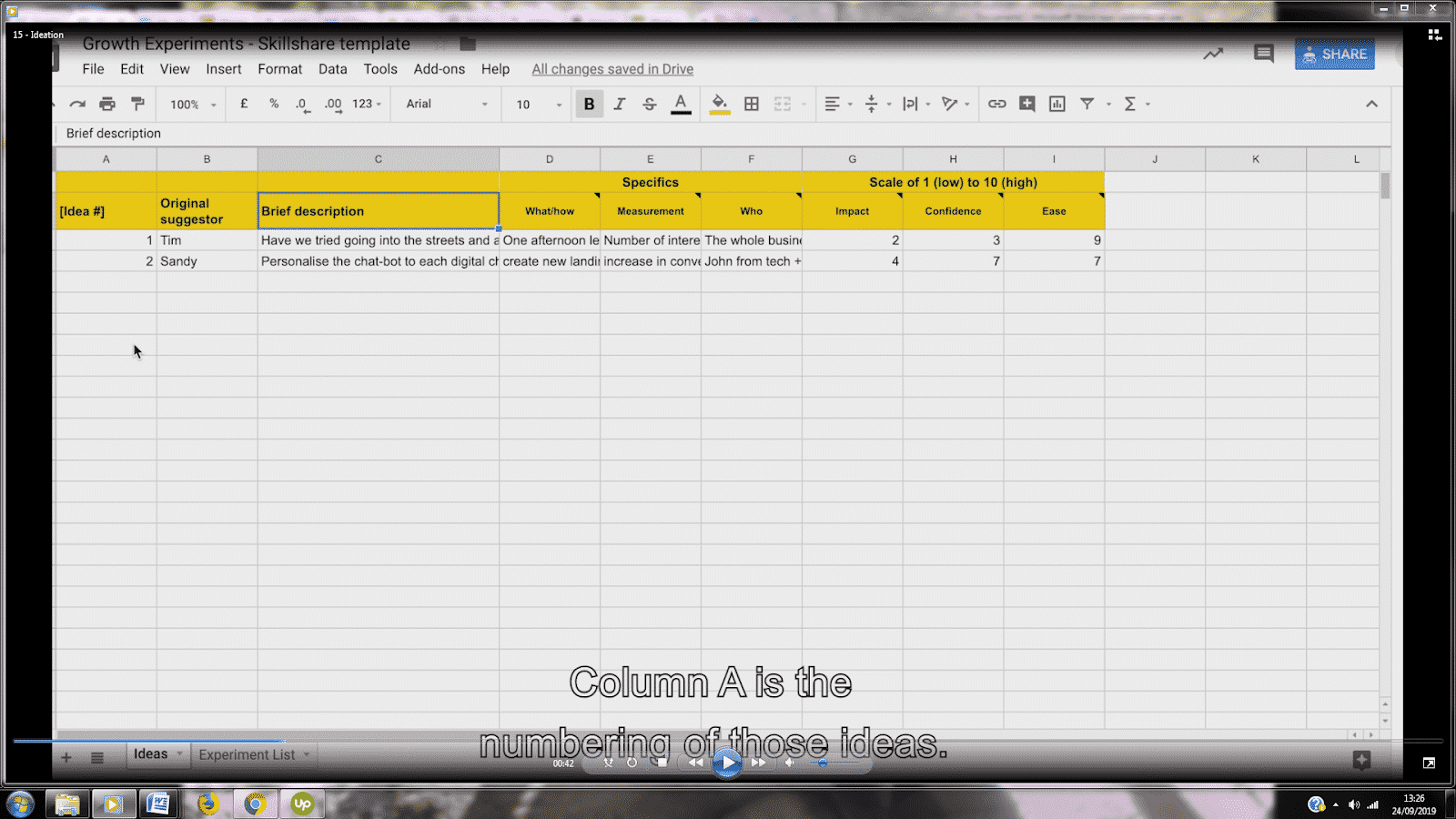 Column A is simply the number of the idea so that each one is easily identifiable. Then column B is the original “ suggestor” of the idea, meaning you can ask them for more details if necessary. In column C we have a brief description of the idea from the suggestor. Column D then goes into a little more detail about what the experiment would involve and how it would be designed. Moving onto column E, the measurement is how the experiment is expected to affect the North Star Metric, if it is successful. Column F states who will be responsible for implementing the experiment. Then in the final three columns we record the ICE score : column G – impact , column H – confidence , and column I – ease . The idea can be ICE scored by the person who suggested the idea or by the growth team. We need to consider: What level of impact will the experiment have? How confident are we that the experiment will achieve this desired impact? How easy is the experiment to implement (with a high score being easy and a low score being difficult, expensive, and time-consuming)? We’ll look at the ICE score tool in more detail in the next lesson. The ideas that are destined to become actual experiments can then be entered into the experiment list section of the experiment backlog.
Column A is simply the number of the idea so that each one is easily identifiable. Then column B is the original “ suggestor” of the idea, meaning you can ask them for more details if necessary. In column C we have a brief description of the idea from the suggestor. Column D then goes into a little more detail about what the experiment would involve and how it would be designed. Moving onto column E, the measurement is how the experiment is expected to affect the North Star Metric, if it is successful. Column F states who will be responsible for implementing the experiment. Then in the final three columns we record the ICE score : column G – impact , column H – confidence , and column I – ease . The idea can be ICE scored by the person who suggested the idea or by the growth team. We need to consider: What level of impact will the experiment have? How confident are we that the experiment will achieve this desired impact? How easy is the experiment to implement (with a high score being easy and a low score being difficult, expensive, and time-consuming)? We’ll look at the ICE score tool in more detail in the next lesson. The ideas that are destined to become actual experiments can then be entered into the experiment list section of the experiment backlog.
Building the experiment list
Here we have the experiment backlog spreadsheet again, but this time we’re looking at the experiment list tab. The shortlisted ideas, with the highest ICE scores (see next lesson), are recorded in this tab. Let’s look at how this next stage of the ideation process works.
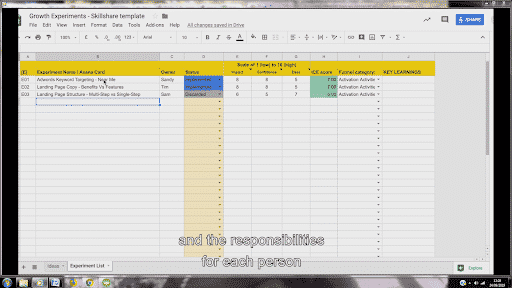 In column A each experiment is numbered , and here we can also insert a link to the experiment template (see step 4 – Execution). Column B records the experiment name and usually each cell links directly to the Asana or Trello card for the experiment. That means you can click on the cell, go into Asana, and flesh out the details, tactical steps, and responsibilities for each person involved in the experiment – design, development, data, etc. Going across to column C, this is the owner of the experiment: the person most passionate about making it happen. In column D we select the status of the experiment: i.e. implemented, in the backlog, in progress, or discarded. If the experiment has been discarded, that might mean that another test provided data that made this one irrelevant, or perhaps there’s been a change in the landscape or we’ve been influenced by the actions of a competitor. In the next four columns (E to H) we return to the ICE score . Here we once again score the experiment based on impact, confidence, and ease; then column H is an aggregate of the three individual figures to create the overall ICE score. A note on the ease score: it’s best to derive this from information pulled from all the team members involved in the experiment. For example, you shouldn’t be trying to estimate the designer’s time if that’s not your area of expertise. Column I contains the funnel category for the experiment. This is important because you need to make sure that the different experiments you’re running are focused on the right funnel stages – i.e. those aligned to your North Star Metric. If the activation stage is key to driving your NSM, for example, then your experiments shouldn’t all be in the retention funnel stage. Finally, in column J we have the key learning from the experiment. Once you’ve run the test and you’ve got the results, you can write down what you’ve learned from the data.
In column A each experiment is numbered , and here we can also insert a link to the experiment template (see step 4 – Execution). Column B records the experiment name and usually each cell links directly to the Asana or Trello card for the experiment. That means you can click on the cell, go into Asana, and flesh out the details, tactical steps, and responsibilities for each person involved in the experiment – design, development, data, etc. Going across to column C, this is the owner of the experiment: the person most passionate about making it happen. In column D we select the status of the experiment: i.e. implemented, in the backlog, in progress, or discarded. If the experiment has been discarded, that might mean that another test provided data that made this one irrelevant, or perhaps there’s been a change in the landscape or we’ve been influenced by the actions of a competitor. In the next four columns (E to H) we return to the ICE score . Here we once again score the experiment based on impact, confidence, and ease; then column H is an aggregate of the three individual figures to create the overall ICE score. A note on the ease score: it’s best to derive this from information pulled from all the team members involved in the experiment. For example, you shouldn’t be trying to estimate the designer’s time if that’s not your area of expertise. Column I contains the funnel category for the experiment. This is important because you need to make sure that the different experiments you’re running are focused on the right funnel stages – i.e. those aligned to your North Star Metric. If the activation stage is key to driving your NSM, for example, then your experiments shouldn’t all be in the retention funnel stage. Finally, in column J we have the key learning from the experiment. Once you’ve run the test and you’ve got the results, you can write down what you’ve learned from the data.
Wrapping up...
So that’s a simple and effective structure that will allow you to collate as many ideas as possible, and then to shortlist the best ideas to implement as experiments. In the next section, we’ll look at the third step in the growth hacking experimentation process: Prioritisation. How do you choose which experiments to run?
Growth Hacking Process Step 3: Prioritisation
In the last section, I introduced you to a practical framework that allows you to collate different ideas for experimentation and begin to shortlist the experiments you want to run. That brings us to the third step in the growth hacking experimentation process: Prioritisation. You’ve collected all the ideas together, but there are far too many experiments – you can’t run them all. In this situation, how do you decide which experiments are the best use of your time and resources? The answer is: use the ICE score. We touched on the ICE score in our last lesson, and you saw that it was included in the experiment backlog (shown again below). It’s an acronym that stands for Impact, Confidence, and Ease. In this section, I’ll go into the ICE score in more detail. We’ll look at how you go about scoring a particular experiment idea, and then how you can use that score to prioritise certain experiments to run.
Breaking down the ICE score
So, you’ve got two experiment ideas in front of you – experiment A and experiment B – and you want to decide which one to prioritise.
Impact
The first thing you ask is: how much impact will this experiment have if I run it? How impactful will it be on my conversion/retention/bounce rate (or whichever result you want to drive)? You estimate that experiment A will have a high impact, so you score it eight out of 10; experiment B you predict will have a lower impact, so you give it a seven. This might seem quite subjective, but actually you can use the data you’ve gained from similar experiments in the past to guide your impact score. Thus, you’ll find yourself getting more and more accurate in your scoring over time.
Confidence
The second question is: how much confidence do I have that this experiment will achieve the desired result? Or, in other words, how sure am I that it will prove my hypothesis? Looking at experiments A and B, you decide that your confidence in experiment A is very high so you score it nine out of 10; however, you are less confident in experiment B, so you give it six. As with the impact score, your confidence score can be influenced by other similar experiments that you’ve already run and have results from.
Ease
The third criterion, then, is the ease score. You need to ask: how complicated and difficult will it be to run this experiment? Do we have the skills and resources necessary to do it well? It’s important at this point to consult the relevant members of your team and draw on their expertise to find out how manageable an experiment will be. Therefore, for experiment A, you might decide that, although you think it’ll be impactful and you’re confident in its success, it’s actually going to be very difficult to run. So, you give it an E score of four out of 10. In contrast, experiment B scored lower in terms of impact and confidence, but you think it will be simpler to run; thus, you give it a nine.
The aggregate ICE score
The overall ICE score, then, is the average of the three separate scores. Experiment A scored: I = 8; C = 9; E = 4. ICE score = 7. Experiment B scored: I = 7; C = 6; E = 9. ICE score = 7.3 That makes experiment B the winner and the one you’re going to prioritise. It’s as simple as that!
Wrapping up...
With so many ideas for experiments to choose from, it helps to have a clear, straightforward formula that you can use to prioritise the experiments in your schedule. The ICE score is a really effective tool for this purpose. So, where are we now in the growth hacking process? We’ve identified the objective for our experimentation, we’ve collected ideas, and we’ve prioritised which experiments to run – the next step is Execution. I’ll show you how to flesh out the details of your chosen experiment using my experiment template.
Growth Hacking Process Step 4: Execution
Now you’ve got your ideas and you’ve prioritised them using the ICE score, so you know which experiments you’re going to run, it’s time to move on to the fourth step in the growth hacking experimentation process: Execution . Each experiment needs to be planned out in detail, in order for it to be executed successfully. To do this, it’s best to use a standard framework to record everything about the experiment; then you can easily compare different experiments and share information with the whole team. Below, I’ll walk you through the different sections of my experiment template and explain how they are used. For further information on the different components of the template, please see the resources section.
Experiment template
To start with, as you can see in the diagram below, we need the number and title of the experiment so it can be clearly identified. Then the first section is the Objective – what you’re trying to accomplish through the experiment, as decided in step one of the growth hacking process. Section two, the Hypothesis , is what you predict will occur if the experiment is successful; thus, a successful experiment with validate the hypothesis. If it isn’t successful, you need to ask: Does that mean the hypothesis was wrong? Or does it mean that this experiment was not the right test to validate the hypothesis? In section three, Experiment design , this is where you would go into the details of executing the experiment. What different components are required to run it? And who is responsible for each task?
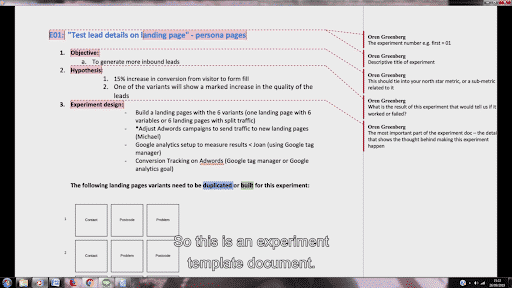
As part of the experiment design section, you can also note down any questions that arise during the course of the experiment planning process. I generally find that when I’m designing an experiment I get a lot of questions from different team members. So what I do is I note down all the questions here and work through them while I’m designing, so I’m taking into account the concerns of all the people involved in the experimentation process. A separate “questions” section also means that team members can engage with the questions when I circulate the document.
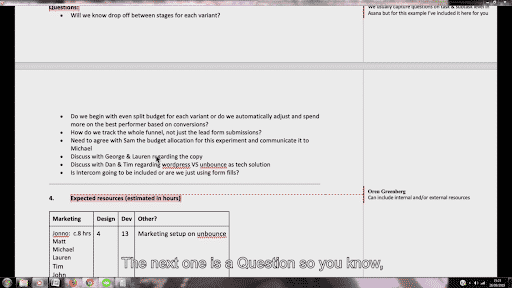
Section four is the Expected resources section. Here you can record the individuals taking part in the experiment and how many hours they estimate the work will take – whether that’s design, development, or another component. The next part, section five, is the Expected results . So, if the hypothesis is correct and it drives an impact on a specific metric, this is where you quantify that outcome. You need to consider all the different components that could impact the metric. Section six is simply where you record the experiment’s ICE score , making sure it matches the experiment backlog.
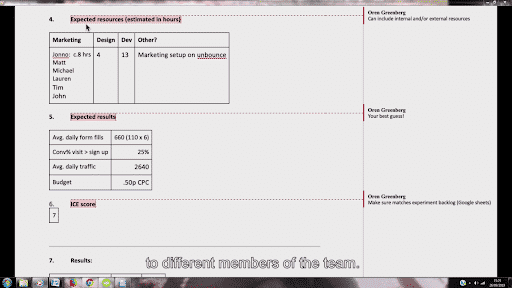
Once you have run the experiment, you can fill in section seven with the Actual results of the test. When you’ve just finished the experiment the results can seem very fresh, but after weeks or months have passed you’re going to struggle to remember – particularly if you have a high tempo of experimentation going. That’s why it’s important to record the results straight away.
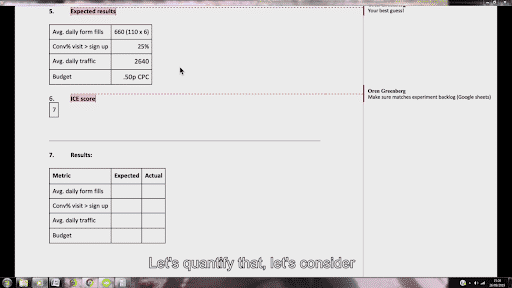
In section eight you can note down the Insights you’ve gained from the experiment. While it’s crucial to record the quantitative results of the test, you also need to think about what you learned from it – i.e. qualitative analysis. Section nine provides another link to the experiment’s Asana card (as you have in the experiment backlog), so that you don’t have to spend a long time searching through different systems in order to find out the progress of the experiment. Finally, in section 10, you have space to write down your Next steps . What are you going to do in response to what you have discovered through this experiment? Perhaps you now have new ideas to test or there’s a new experiment you could run. Or maybe the experiment failed and you know you need to delete a set of similar experiments as they won’t be productive to carry out.

Wrapping up...
Using a clear experiment template like the one above will allow you to fine tune each aspect of the experiment and keep control of the whole process. It’s an opportunity to clearly record your results so that, even if the experiment isn’t a success, you’ll still have something to learn from it. The next step in the growth hacking experimentation process is Implementation. I’m going to take you through a case study which demonstrates the importance of refining the details of your experiment for optimal results.
Growth Hacking Process Step 5: Implementation
Once you’ve prioritised and executed your experiment – and perhaps you have a few running at the same time – it’s important to maintain a high quality of experimentation. That is, Implementation is key : it deserves its own step in your growth hacking process. You want to avoid running experiments at too high a velocity, or running too many experiments all at once – that could mean you’re compromising on the quality of execution. In this lesson, I’ll share a case study of experimentation where we paid close attention to implementation and enjoyed success as a result.
Hypothesis
Remember our client with the app for hiring tradespeople? As I explained in a previous lesson, we were in the process of driving traffic from Google Ads to a landing page, where the customer was asked to fill in a contact form in order to download the app. We had a hypothesis that the order in which we asked the customer to submit their details would affect the likelihood of activation. That is, we thought that one particular order would be most likely to encourage the customer to go through with the sign-up process.
Testing variants
So we decided to test six different order variants of three customer information fields. As you can see in the diagram below, these were: contact information, postcode, and problem. Why did we need this information? We needed the person’s email address because the app could only be downloaded via an email link (and without the app there was no service). We needed to know the postcode because if the customer did not live in the specific catchment area, the app could not provide a service to them. Finally, we had to know the problem (a blocked drain, faulty wiring, etc.) to determine whether or not the app covered that issue.
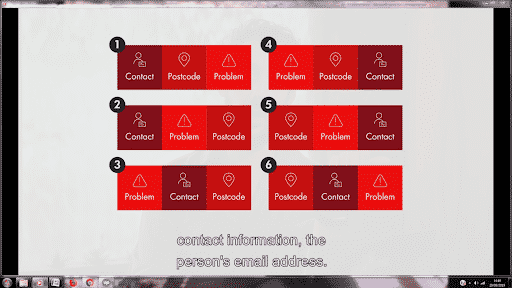
These three components formed the foundational information we required from the customer. The question was: What is the most effective order to request this information? Each detail has a different level of sensitivity. From most to least private we have: contact information, postcode, and problem. That might give you a clue as to the most successful variant that we tested.
Result
In fact, the result wasn’t quite so straightforward as you might have guessed. The most successful variant was number five: postcode, problem, contact. This was 72% more effective than the least effective variant of the six.
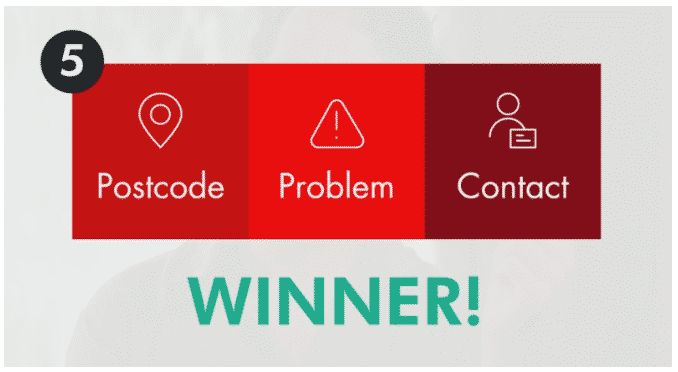
So, yes, leaving the most sensitive piece of information – the email address – to the end helped to activate the customer. However, having the postcode before the problem worked better, despite the postcode seeming more private than the problem. Therefore, you can see how important implementation is to a successful experiment. You need to think carefully about the different variants you are testing against each other, and design an experiment that will allow the best variant to be identified. It’s easy to make assumptions based on a hypothesis, but a carefully implemented experiment is needed to validate your theory.
Wrapping up...
We’ve discussed how a focus on the implementation of the experiment will allow all your hard work on prioritisation and execution to pay off. Maintaining a high quality of experimentation without being distracted by too many different experiments is crucial. In our next section we’ll look at the sixth and final step of the growth hacking process: Analysis. How can you effectively analyse the results of your experiments?
Growth Hacking Process Step 6: Analysis
Our final step in the growth hacking experimentation process is Analysis . Having set an objective, gathered ideas, and designed and run the experiments, what is the most effective way for you to sit down with your team and analyse the results? What I recommend is a weekly sprint meeting with five core components. Here, I’ll take you through each of these components in turn so you can get a feel for the shape of the meeting.
1. Beginning the week
We hold our experiment agenda meeting on a Monday, and the first thing we do is to look at how our North Star Metric has been trending since our last meeting a week ago. We consider whether or not we’re going in the right direction – are we successfully driving this metric? In addition, we’ll discuss what variables are impacting it. These might be competitors, seasonality, changes in the product, etc. Ideally our experiments have impacted the NSM positively.
2. Reviewing the experiments
That brings us to the experiments themselves. We spend 10 minutes reviewing the experiments that we ran during the previous week, and we look at how they have been performing. Do we have any useful quantitative data? Or are the results inconclusive?
3. Learning from results
So, taking the results of these experiments, we want to find out what we can learn from them. We should ask whether the results and the original hypothesis are aligned. If not, why might this be the case? Was the hypothesis clearly mistaken or were these experiments the wrong ones to validate the hypothesis?
4. Selecting new experiments
The next step of the weekly agenda is to select the experiments that we will run in the coming week. As our meeting is on a Monday, we choose tests to execute from Monday to Friday. In order to select the experiments, we go to our backlog and find the experiments that are already prioritised. Then we have a discussion to make sure that we still want to run these experiments. Do we have the resources allocated? Is the hypothesis sound? Once we’re sure that we’re confident in the design of the experiments and happy with the team responsible for them, we give the next batch of tests the go-ahead.
5. Looking to the future
The final stage of our weekly sprint agenda is to review the idea backlog. We make sure that we have enough ideas in there for the future, in order to run further experiments in the coming weeks. If we’re running low on ideas then now is the time to circulate the ideas spreadsheet again and renew the process of collating and prioritising.
Wrapping up...
That brings us to the end of our six-step growth hacking experimentation process. We’ve used the SMART framework to identify the objective for experimentation; we’ve collated ideas for experiments and prioritised them using ICE; we’ve executed the experiments, maintaining a high quality of implementation; and finally we’ve gathered our team to analyse the results. In the next section, as we near the end of this guide, we’ll look at some case studies of businesses that have used growth hacking techniques successfully and think about what we can learn from them.
Growth Hacking Case Studies – Good
Now that we’ve gone through all the theory of the growth hacking framework and looked at how to put it into practice, I want to share some case studies of growth hacking in action. Below, I’m going to tell you briefly about two businesses that employed the growth hacking mindset and successfully achieved growth.
Case study 1 – RJMetrics
My first case study is the analytics platform RJMetrics. In order to attract new users to their platform, RJMetrics offered a trial period where users could test out some of the analytics tools for themselves before committing. Through their growth hacking experimentation, the company found that users who signed up for the platform and created two graphs during this trial period had a much higher propensity for retention than other users who took part in the trial but didn’t create two graphs. Even more interestingly, they discovered that users who created more than two graphs during the trial period had a yet higher propensity for retention. So in response to the experimentation, RJMetrics was able to identify a key metric for growth: drive graph creation during the trial period and retain more users .
Case study 2 – “Anonymous”
My second case study is a very large business, one of my clients, whose name I unfortunately can’t reveal. The business had their own app and they were keen to boost user engagement with it. When we were carrying out tests for this business, we found that when a user invited a certain number of friends to download the business’s app within a certain timeframe, and those new users then took three specific actions, their retention rate was 95%. Essentially, we had almost perfected the process of replicating the sequence of events for that specific audience – a proven, effective methodology for increasing engagement with a mobile app. And we had achieved this through a growth hacking mindset that focused all marketing activity, all experimentation on driving the North Star Metric.
Wrapping up...
With these two case studies we can see the growth hacking core principles in action. These businesses ran lots of different experiments, iteratively, refining and testing more specific metrics – and all the while with a focus on driving their North Star Metric. In addition, their experimentation allowed them to accurately identify when the Ah Ha! Moment was occurring, and to see the pattern of events that led to it, enabling them to replicate it again and again. So that’s two fantastic examples of businesses that used the growth hacking methodology successfully. Next we’ll look at two case studies of businesses that made fatal mistakes, and thus were unsuccessful in driving growth long-term.
Growth Hacking Case Studies – Bad
Having given you two examples of businesses that used growth hacking techniques successfully, now I’ll share two case studies of businesses that made fatal mistakes. These are businesses that both could have benefitted from the growth hacking mindset, but that were either too focused on a traditional marketing approach or did not consider marketing seriously enough. Let’s have a look at their stories...
Case study 1 – BranchOut
Our first case study is BranchOut, which you might remember as the “LinkedIn” app on Facebook, designed for job searching, professional networking, and recruiting employees. It enjoyed exponentially incredible growth – from 3 million to 25 million users in under three months. Unfortunately, this phenomenal growth didn’t last. BranchOut started to leak users, and this leak grew and grew until they were losing 4% of their users every single day. From huge growth to massive shrinkage – until finally they went bust. “So what went wrong?” you ask. “How did a skyrocketing company that was competing with the likes of Airbnb, Facebook, and Twitter fail so badly?” The answer is simple: the product wasn’t good enough. If you’re really effective with your marketing but the product isn’t up to scratch, that’s just going to accelerate the demise of your business. What can we learn from this? Well, when you bring in the growth hacking framework to your business and start running marketing experiments and campaigns, that doesn’t mean that you can ignore the core value of your product or service. In fact, that’s what makes growth hacking different from traditional marketing – it actively encourages you to integrate product development and marketing. By focusing on your North Star Metric and your Ah Ha! Moment, you’ll never forget the importance of core product value.
Case study 2 – EverPix
Our second case study is EverPix, a fantastic service that allowed users to store, sort, and share photos. Now apps in that sector tended to hover around the 1% conversion rate, but EverPix was enjoying a phenomenal 12.5% conversion rate from free trial to a paying user. That’s because users loved the app and were sharing it with their friends. The team at EverPix were very proud of their product; they were continually working to improve it and it had really fantastic traction. That problem was that even as they were acquiring all these customers, they weren’t able to recoup the costs of product development quickly enough. By the time that EverPix realised their losses and tried to raise more money, it was too late. From achieving such phenomenal growth at an early stage of trading, they plummeted out of business. For EverPix, then, their issue was just the opposite of BranchOut’s problem. They were so deeply concerned with the quality of their product that they didn’t focus on marketing and monetising it early enough. The growth hacking mindset would have helped them to balance the cost of their product development with the funds coming in from their new users.
Wrapping up...
So that’s two examples of businesses that made fatal errors and paid the price. The first focused too heavily on marketing and did not provide a quality product; the second offered a great product but failed to make the business financially sustainable. Growth hacking, with its emphasis on both core product value and getting the product sold to the right audience for the right price, could have helped both these businesses to persevere in their original success. That’s why it’s well worth introducing the growth hacking mindset into your own business. In the next and final section, we’ll address some common misconceptions about growth hacking – what it is and what is can achieve.
Conclusion – Growth Hacking Misconceptions
Let me end this course on the growth hacking framework by resolving some common misconceptions about growth hacking. Here are three mistaken ideas that I often come across, from people who are just getting started with growth hacking or who haven’t quite grasped the concept yet.
“Give me a growth hack”
It’s not unusual for someone to say to me, “Hey Oren, Can you give me a growth hack that will grow my business?” But as those of you who have been following the course will know, there’s no such thing as a one-size-fits-all growth hack. There might be certain tips or techniques that could be called growth hacks; however, they’re often
-
a) timely, so they may not be suitable for your business right now, or
-
b) tailored to a particular kind of business, so they may not work at all for your specific company.
My advice is not to follow any blind “hacks” that you’re given, because they can end up getting you into trouble. That’s especially true if you’re breaking terms and conditions for some businesses or doing anything remotely dodgy. I certainly wouldn’t recommend getting involved with anything that could jeopardise your business. Real growth hacking is a proven experimental methodology that can get you effective results in a structured, professional way.
“It came out of nowhere”
Another big misconception about growth hacking is that growth is really sudden. For example, people will say: “Facebook just sprang up out of nowhere!” And this is simply not true. It took 15 years for Facebook to get where it is today, through an incremental and iterative process. Therefore, you shouldn’t fall into the trap of thinking that people who employ the growth hacking framework are achieving instantaneous growth. In fact, they’re running lots of different tests, they’re doing some things right, they’re doubling down on what’s right, and they’re getting rid of what doesn’t work. It’s important to remember that effective growth hacking is about stimulating gradual, progressive growth that is sustainable for your business; it’s not about quick fixes.
“It went viral”
The next major growth hacking misconception, which ties directly into the idea of sudden growth, is virality. “They used growth hacking to make their product go viral!” you might hear. But, no, they didn’t – and here’s why. Virality can’t be engineered. We don’t know the reason why some things go viral. There are some characteristics that define things that have gone viral, and which they might have in common. However, that doesn’t mean you can actually reproduce the viral effect. So when you’re developing your marketing strategy, don’t waste time thinking about how to achieve virality. Instead, aim to get more specific about the metric you’re trying to drive, and focus more experimentation on that. If something goes viral, fantastic, but you can’t engineer this and I don’t recommend trying.
Wrapping up...
Those were three common misconceptions about growth hacking that you can disregard. Remember: growth hacking is specific to the individual business; it’s about driving gradual, incremental growth; and it requires iterative experimentation to boost your North Star Metric. That concludes this guide to the growth hacking framework and mindset. I hope you’ve found these lessons helpful and that you’re now inspired to begin your own growth hacking journey! Further information and resources are available on the Kurve blog.

Oren Greenberg has a proven track record for growing startups and scaleups. To speak to Oren about what you can achieve with Kurve as a growth marketing partner, get in touch today.











